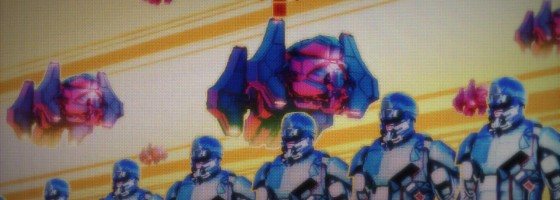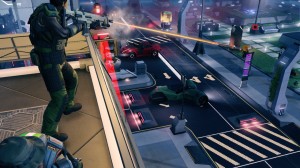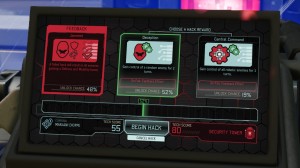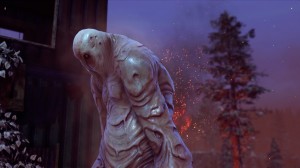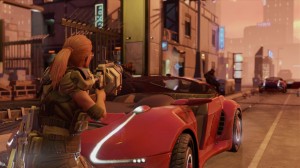This review and game shouldn’t need an introduction at this point. I’ve been talking about my excitement for XCOM 2 since the announcement and very frequently on the podcast. With the game finally out, it’s time for me to tear into the sequel to one of my favorite games of recent years.
Known and Outside:
XCOM 2’s story takes a different approach compared to other sequels. The game’s canon is that the aliens completely took over the Earth in XCOM EW; destroying the X-Com project and leading to the commander (AKA you) getting captured for 20 years. Since then, the remnants of X-Com went underground and prepared for the day to get you rescued so that you can once again lead the fight.
If you completely missed the X-Com franchise, here is a brief primer. The series is all about macro level strategy in terms of deciding how to build your operation, train your troops and where to strike; coupled with a tactical layer of leading your troops into combat. When Firaxis reboot the series with XCOM Enemy Within, they streamlined the game’s complexity for modern audiences while still keeping the feel of the original.
XCOM 2 marks Firaxis’s first full title in the series that they are building on their own designs and growing in new directions and it shows: with every aspect of the original either altered, rebalanced or changed altogether.
That means we have a lot to talk about in this review; starting with the strategic layer.
Revolution:
In the previous game, you were setup inside a mountain base and sent your troops around the world to strike at the aliens. With the world now under alien control, you’ve lost your mountain base but gained a mobile command base built out of a crashed UFO.
The grand campaign style of the previous game has been given a number of tweaks. Your starting position, along with continent bonuses are all shuffled when you create a new game. Instead of having panic levels dictate the losing scenario, the aliens have their own plans this time. As the game goes on, the aliens will be working on something called “the Avatar Project.” This is done at select facilities called blacksites around the world. Leaving these sites up will cause the project to gain progress and if it finishes, it’s game over. You can combat this by attacking the blacksites, which a successful mission will lower the progress.
Previously, satellite coverage allowed you to reduce panic and earn monthly resources. This time, you need to make contact with the various resistance cells around the world and set up communication towers. In turn, they will provide you with monthly supplies which are the new credits, and will let you get in touch with neighboring territories.
A secondary resource called intel is used to make contact, buy resources and bonuses at the new black market and is key to spreading your influence. You’ll need to make these contacts, because you can only access blacksite missions in territories that you have already established a connection with.
As before, your main challenge here is deciding what to take on over the course of a month. Points of interests will appear that can grant you bonuses if you look into them; while you’re getting alerts about missions and situations going on.
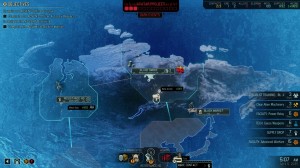
Managing the operations of XCOM is a lot harder this time around; with a countdown to failure to boot
A new twist on the game are “dark events,” the aliens will look to gain an advantage over you. Each month, they will have 2 to 3 events in the works that if completed, will provide them with a special buff for a month.
This includes but not limited to: Additional enemies on a map, armor bonuses, reduce the time before the next retaliatory strike (XCOM 2’s take on terror missions,) and more.
Compared to the first game, I like how random and more reactive the grand campaign is this time. Previously, it felt like things were too similar between plays and deciding on what to do.
The satellite system became very easy to break and you were either barely scrapping by or rolling in resources. The changes made keep things from playing out the same way each time, while still giving the player a goal to go for.
As with any good strategy layer, it’s not about picking the best option, but deciding what you want and what you are willing to give up and hopefully make up for it later on.
Inside your ship, the base building layer has also had some renovations.
Cleaning Up:
Again, comparing XCOM 2 to XCOM, the new base system has a number of improvements over the original. Gone are the building type adjacency bonuses that awarded placement of rooms (there is only one building that gives them out and that’s the workshop;) the system was too easy to abuse and punished the player if they didn’t. Now, every room past the first one needs to be renovated before building it out; costing time but rewarding you with resources when completed.
As before, you’ll acquire engineers and scientists to help with construction and research respectively. Engineers are a lot more important this time around; they can provide benefits to rooms that they are stationed in and are required to open up new rooms in your ship. Research works the same as before, as you’ll need to scavenge enemy corpses and equipment in the field to be researched to unlock new tools for you; scientists gate working on certain researches and decreases the overall time needed to unlock it.
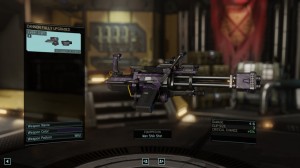
Both your squaddies and the weapons available now have a lot more ways to be personalized as the game goes on
Due to the limited space and time needed to open up new rooms, you are still forced to make some hard choices on what to get first, but it feels far less restrictive compared to the first game.
Too much of EW’s choice at the base layer was about setting things up for the adjacency bonuses; making it repetitive once you knew what you were doing.
This time around, you are given a longer leash in a manner of speaking of how you want to progress: Do you rush advanced weapons and armor? Spend time upgrading your squad and squaddie’s capabilities, or even go after psionic research and field some psi operatives.
Another great touch is the new facility called the proving grounds. Here, you can spend resources to create a new secondary piece of gear such as grenades or ammo, with the twist that the item’s effects will be randomly selected from a pool; allowing you to create things like acid grenades new ammo and more. Speaking of resources, you will once again have to decide how to spend your limited resources; as weapon and armor upgrades are more expensive, but unlock for everyone when relevant once done.
All the research and engineering in the world won’t matter without your troops, as we come to one of the bigger changes to the game.
A People Person:
Your troops or squaddies are your boots on the field; all throughout X-Com’s lifespan, people have been giving them names of friends and family and trying to make them more personal. Firaxis definitely listened on this regard, giving XCOM 2 one of the most exhaustive character customization toolsets seen in a strategy game (and some RPGs,) Every part of your squaddie can be personalized: Gender, nationality, different pieces of armor, cosmetic options, color and I’m probably forgetting a few others.
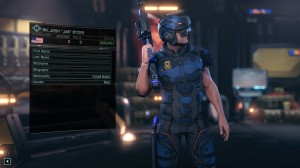
The character pool lets you create a variety of new characters easily, and then use them in your game or upload them for friends to try out
As characters go up in rank, they’ll unlock more cosmetic options to showcase their bad-ass-ness, or make it that much more painful if they are taken out.
A new feature is the character pool, which allows you to preserve characters that you like.
Once a character has been added to the pool, they have a chance at showing up in subsequent games; either as a recruit or NPC that shows up as a mission objective.
The character pool is a genius move on Firaxis’s part. Previously, it was hard to really care for your squaddies (at least for me,) as they were only available for that one game and once killed, all the time spent on them was lost. With the character pool and the editor usable outside of the main game, commanders can now create a platoon of personalized people who can then make an appearance.
And yet there is still more to talk about with your squaddies, as we get to combat.
Dressed for Success:
Previously in EW, Firaxis made the change of squaddies entering one of five classes that would define their equipment, stats and skills during combat. The classes have made a return in XCOM 2, with each one being redesigned for the time jump and changes. Your new group consists of Sharpshooters, rangers, grenadiers, specialists and Psi troops (once unlocked,) and an unannounced sixth class that will be due out sometime in 2016.
Just like before, each class has two skill trees that you must decide how to grow that character with each promotion. However, the choices for each track are a lot more interesting and harder to decide. The sharpshooter for instance can either specialize in long range and elevation-based skills and perks, or become better with their pistol; allowing them to attack multiple times per turn and at more targets.
The beauty of the redesign is that it’s a lot harder to find “the perfect way” to build each class; you’re going to want multiple people now to specialize differently. As an added bonus, one of the first buildings that you can construct will allow you to auto promote rookies to a class of your choosing; meaning, you are no longer at the mercy of RNG for this point.
Combat options for your squaddies have gotten a lot more “fiddly” compared to EW and that is not a complaint.
Besides the class, one of the buildings you can construct will give squaddies a chance to unlock a second skill from another class; further customizing them. Combat stims can be found or bought and given to a squaddie to enhance them in some aspect.
But wait, there’s even more; as weapons can now be customized using mods found off of random enemies. The mods offer additional benefits and can synergize with the different class abilities to give you more personalization options.
The new skills go great with the upgraded missions which we’ll talk about next. Because there are less “perfect builds,” it really allows the player to explore the skill trees and come up with interesting strategies. Every class has a useful role, and a lot of the fun of the game will be creating different party and skill compositions.
All these new changes are obviously going to be felt the most during a mission, and takes us to the final set of big changes to the game.
Hitting Them Where it Hurts:
The mission variety in XCOM 2 is far greater compared to the original. While you will still be killing aliens, new objective such as defending VIPs, destroying important structures and more help to keep things interesting.
The procedurally generated maps are a very welcomed change; keeping you on your toes no matter what. The two big features added to XCOM 2 are concealment and timed missions.
Concealment allows your team to remained hidden at the start of most maps; free to wander around as long as you don’t enter line of sight of an enemy. This allows you to set up your point of engagement and get a free overwatch ambush on an unsuspecting group of enemies.
Most missions are now timed; forcing you to complete the objective before a given number of turns. Best case scenario of missing the turn limit is losing out of the bonus for the mission, worse case scenario is losing all your troops.
While you have been given a huge upgrade in terms of gear and tactics, the variety of enemy types has been greatly expanded.
Old “favorites” like the Mutton, Sectoid and chryssalids are back with new abilities and tactics, and the game introduces a lot of new enemies who will certainly cause some trouble.
With the time limits and the three turn chance to pick up dropped items, makes XCOM 2 a lot more quicker to play than the original.
The combination of your upgraded skills and the enemy tactics and abilities, coupled with possible dark events interfering, keeps the tactical layer from growing stale or getting to the point of it becoming a routine.
Phew, it feels like I’ve typed up a short story, and we’re still not done. With everything said, it’s time to talk about the big question that matters the most: Is XCOM 2 a good game? The answer to that is yes, but I do have some points to talk about.
Cracks in the Coalition:
From a design point of view, XCOM 2 is miles above the original XCOM. The amount of changes and additions to the formula are a masterstroke of design from the team at Firaxis; showcasing a jump in sequel quality similar to Assassin’s Creed 1 to 2. With the improvements to both modding tools and Steam Workshop integration, give experts like Long War Studios and newcomers plenty to work with to further grow the game. Adding in more randomized elements to the meta-game and grand campaign help to keep things from becoming routine as they were in the original game.
However, there are a few issues to talk about; some design related and some back-end. In terms of design, XCOM 2 is still built off of the foundation of EW, meaning that a lot of the quirks of the original are still here.
Expect to have cases where a string of bad luck can cost you the game; along with line of sight/detection problems and the limitations of the base gameplay mechanics. The higher in difficulty you play, the more luck factors into the equation instead of player skill.
On legend, there are more enemy groups per mission, all timers on the meta game are increased, and unless your first month goes perfectly, you will not be able to catch up. The level in which the meta-game’s win/lose factor hinges on perfect plays is a constant frustration I have with Firaxis’s take compared to the original.
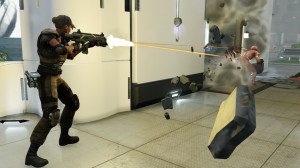
As with Enemy Within, expect encounters and your whole game to sometimes come down to the luck of one turn
There is simply no build up or grace period; the first two months of your campaign are going to play out the same every time: You’re going to have to have a perfect or near perfect play and get the foundation needed to win, or you’re going to fall behind with troops and tech and lose; with further pressure from the build up of the avatar project,
And that perfect play relies too much on luck in my opinion.
On the very first mission for instance, alert both groups (or three on legend) and unless you have incredible luck, You. Are. Done; there is literally nothing that the player can do from a tactics’ perspective to change it.
Failing one battle should not completely cut you at the kneecaps, especially when it’s literally during your first month. The ever important upgrade of improving squad size is still locked behind set promotion ranking; further making it difficult to progress unless you are able to have a strong start.
To be fair to the design, the added class abilities can help mitigate falling behind in tech and research to a certain extent, at least until advanced and armored units show up. Another point is that the meta-game can be a bit confusing for new players, with multiple events and situations to deal with, it can be overwhelming to learn.
The meta-game itself is a lot bigger compared to the first game, but that also means more moving parts to juggle. The meta-game, combined with the pace at which the aliens progress leaves the player with very little time to get used to it before they start to lose control of the situation.
The game teases you with all kinds of rewards from the points of interest, but as a new player, it’s hard to put two and two together and figure out how something is going to help you now vs. down the line. Knowing what to save for important research and what can be sold safely also takes time spent playing to learn. Of course, the metagame is something that you will figure out over time, but it’s a case of learning by failing and restarting rather than learning through the game itself.
The new way that items are built require a lot more resources compared to the first game; unless you are in desperate need of something from the black market, it’s better to hold onto items or you may find yourself with the tech unlocked, but not the resources to make use of it.
From a stability standpoint, a lot of people are reporting problems with the game; I had slowdown, CTDs, long load times and commands not working. XCOM 2 seems to require a very beefy machine to run properly at the moment, and I’m really hoping that there will be some optimization patches sooner than later.
Turn-Based Quickness
Then we have the berserker in the room: the timed missions. In the original game, the timed bomb deactivation missions were some of the least popular ones in the game, and having that system now make up the bulk of the mission types has some players flustered.
The problem stems from a push and pull of the design. The developers wanted to combat the methodical and overwatch-heavy play of the original, and they did that by forcing the player to be on the move. The issue that people are having is that it goes back into that negative feedback loop seen in the original.
If someone is lucky with map generation and manages to kill enemies quickly and efficiently, then the turn limit poses no problems.
Get an enemy who is dug in, have poor aim or accidently trigger multiple enemy groups, and it becomes very difficult to make progress within a time limit; once again putting luck as a major factor of playing the game.
One other factor, since maps are procedurally generated, it’s possible to run into additional problems by the layout and the evac position.
In the original game, activating multiple groups was bad, but not an instant lost; you could retreat to a better position and try to take them on your own terms. With XCOM 2 however, that is simply not possible on timed maps; falling behind in reaching the objective will cascade into failing the mission. Given the penalty of possibly losing your entire squad due to poor luck,the lost can sometimes not be worth the risk.
While my preference for rapid moving and quick plans makes it so I don’t feel the problem as much, I can see where people are coming from. In terms of mechanics/systems, nothing was added to compensate the player for having to deal with enemies faster; such as new tactical options, nor can you effectively “stealth” the map to reach the objective without triggering all the groups you skipped.
Fighting the Future:
XCOM 2 despite my complaints is an amazing title and a phenomenal sequel to one of my favorite games. For fans of the original, you are going to love this game. However, if the changes and quirks of the original’s design bounced off of you, the same underlining design is still present and will frustrate you as much now as it did with EW.
Just like with EU, Firaxis isn’t done with developing XCOM2, and there are currently plans for three more DLC packs at the moment; of course there will be patches as well to hopefully fix the problems people are having.
As the saying goes: You only hurt the ones you love, and my love-hate relationship with XCOM continues with XCOM 2. We’re only two months into 2016, and we definitely have one of the front runners for game of the year. For videos on XCOM 2, you can check out my playlist, but don’t be expecting winning plays any time soon.

